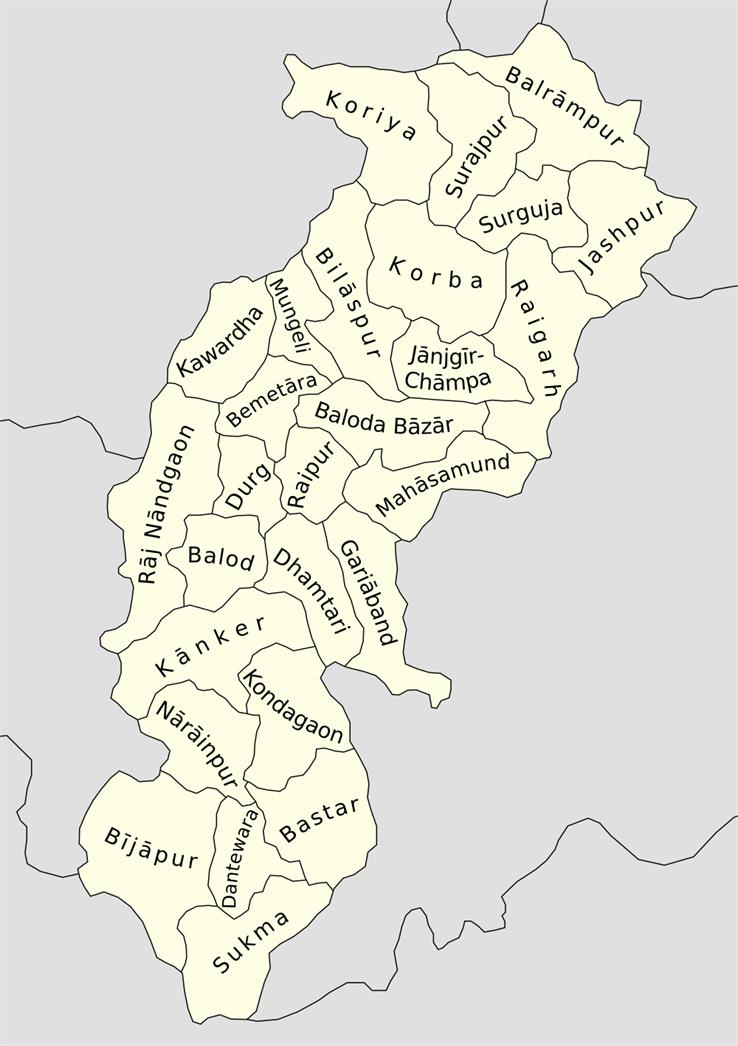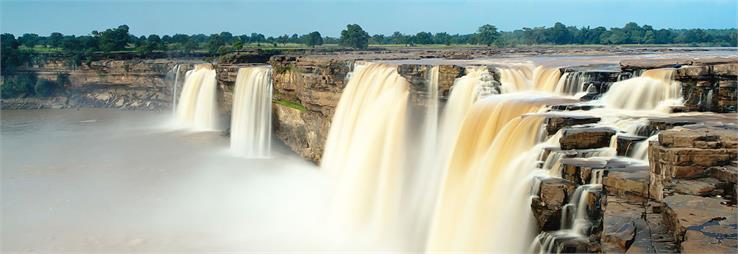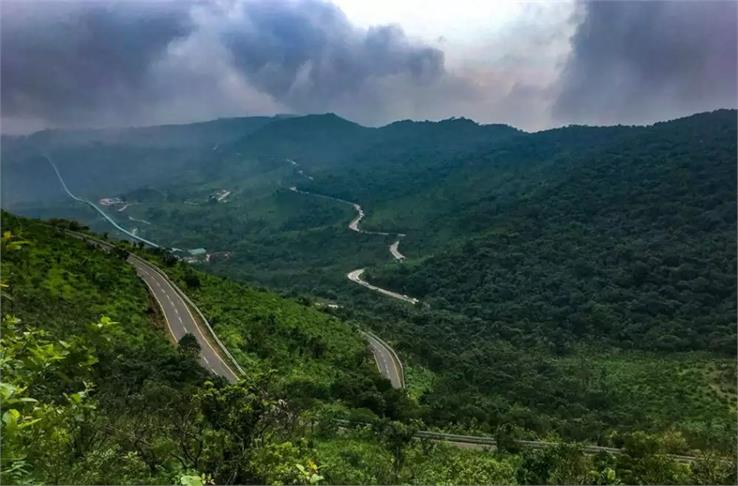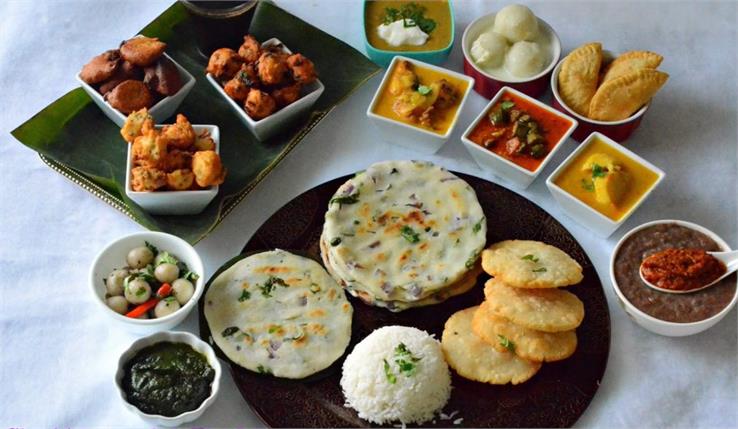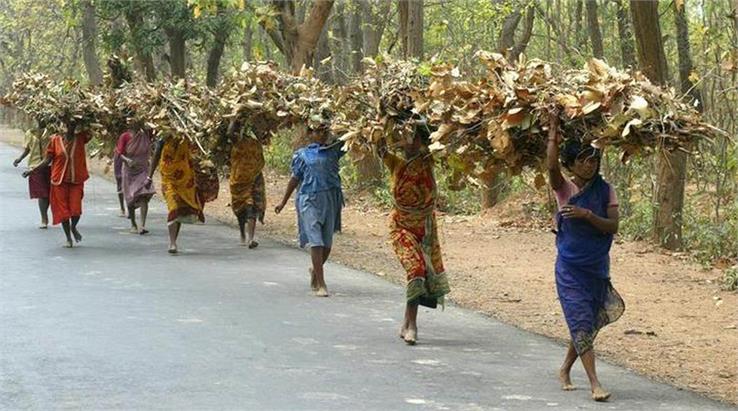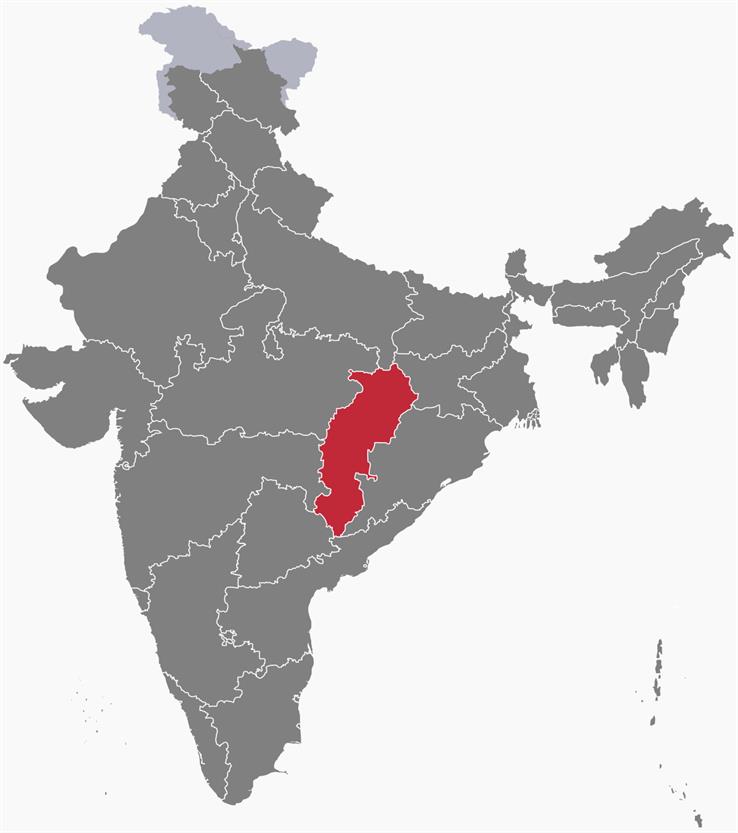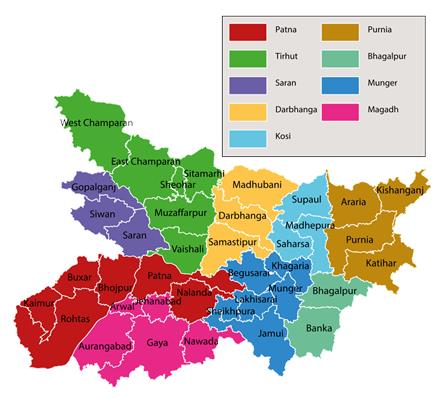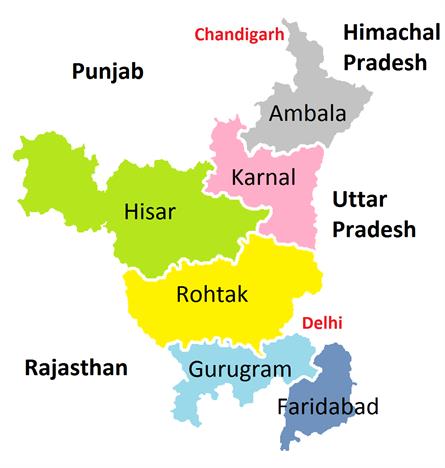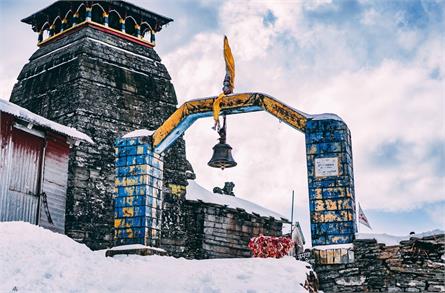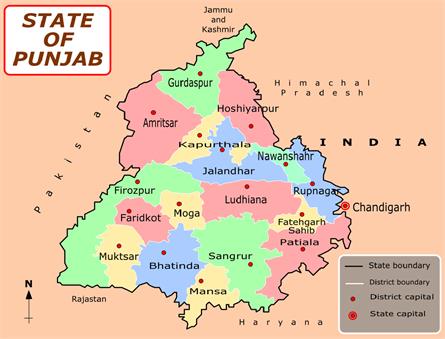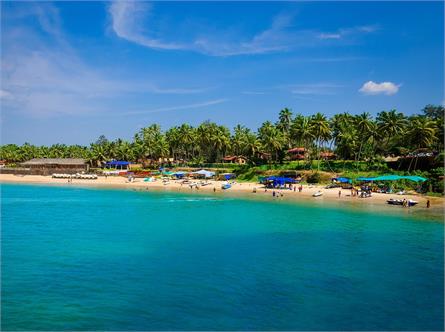Chhattisgarh - The Bowl of Minerals
India's incredibly youthful tourist destination known for its natural beauty, Chhattisgarh boasts rich cultural heritage, with crunchy cuisines, vibrant dances, melodious music, diverse religions, amiable/sociable languages, sparkling fairs and festivals, and lively people. Chhattisgarh has been Lord Rama's workplace and is extremely rich in terms of ancient art, civilization, culture, history, and archeology. The state has been the center of development for various cultures since past times. The ancient temples and their remains show that the Vaishnav, Shaiv, Shaktas, Buddhists, as well as many Aryan and non-Aryan cultures, have been influenced from time to time.
There are two areas in India, in particular, whose name changed slowly due to special reasons. The first was 'Magadha,' which became Bihar due to Buddhist viharas and the second 'Dakshin Kaushal', which became 'Chhattisgarh' due to the ‘Thirty-Six Strongholds' of Devi temple. Both areas have been making India proud from immemorial time.
Foundation of the State
On November 1, 2000, Chhattisgarh separated from Madhya Pradesh and came into existence as a new state of India. The land area of Chhattisgarh is 4.14% of the total land area of India. Thus, Chhattisgarh is the ninth largest state in the country in terms of area.

The area of Chhattisgarh is merely 30% of the Madhya Pradesh, which spread over 135,191 sq km. From the Raipur District Congress meeting in 1924, the idea of creating a new Chhattisgarh put forward. The leaders of this meeting thought, “Chhattisgarh is historically and culturally different from Madhya Pradesh.”
There are a total of 27 districts in Chhattisgarh, and its High Court is in Bilaspur. Raipur is the capital of the state of Chhattisgarh. The Legislative Assembly of Chhattisgarh has 90 members.
History
This state, formed from Madhya Pradesh, came into full existence on 1 November 2000 as the 26th state of the Indian Union. Earlier, Chhattisgarh was a part of Madhya Pradesh for 44 years. It was known as ‘Dakshina Kosala’ in ancient times. This region is also mentioned in Ramayana and Mahabharata. Sarabhpuria, Panduvanshi, Somvanshi, Kalachuri, and Nagvanshi dynasties rule over the region between sixth to twelfth centuries. Kalachuri (from 980 to 1791) and Nagvanshi rulers ruled Chhattisgarh for a longer time.
The Heheya dynasty ruled Chhattisgarh for about six centuries around the 14th century. The Chalukya Empire established itself in Bastar in the Middle Ages. Annamdev was the one who built the dynasty in Bastar in 1320 AD and became the first Chalukya ruler. In 1741, the Marathas seized this dynasty from the Heheya rulers. The Marathas forced Raghunath Singh Ji, the last descendant of the Ratanpur Gharana, to leave the region in 1745 after winning the kingdom. Ultimately, in 1758, the Marathas conquered Chhattisgarh, and Bimbaji Bhonsle was declared as the ruler. After the death of Bimbaji Bhonsle, the Marathas started following the diocese system (Subah System).
Geography
The heavily forested state of Chhattisgarh is located in the south-east of Madhya Pradesh between 17°46' North latitude to 24°5' North latitude and 80°15 'East longitude to 84°15' East longitude lines. Chhattisgarh is the third largest state of India in terms of forest area. The forest area of the state is 44 percent, which shows the different topography here. Chhattisgarh has about 12 percent of the total forest area of India, which presents its vast biodiversity, rich in timber and various wild species. Southern Jharkhand and Orissa bound Chhattisgarh in the east, Madhya Pradesh and Maharashtra in the west, Uttar Pradesh, and western Jharkhand in the north and Andhra Pradesh in the south. There are five divisions (Bastar, Durg, Raipur, Bilaspur, Surguja) and 27 districts in the state of Chhattisgarh. The area of Chhattisgarh is more than the sum of three states: Punjab, Haryana, and Kerala. Apart from this, the expansion of Bastar (the division of Chhattisgarh) is larger than the area of Kerala.
Major Cities of Chhattisgarh
- Raipur
- Bhilai
- Bilaspur
- Korba
- Raj Nandgaon
- Raigarh
- Jagdalgarh
- Ambikapur
- Dhamtari
- Chirmiri
- Bhatapara
- Mahasamund
- Dalli Rajhara
- Kawardha
- Champa
- Naila Janjgir
Climate
The climate of Chhattisgarh has all the characteristics of the monsoon climate. The atmosphere of this region is hot-humid, which is commonly known as tropical monsoon climate or dry sub-humid. Chhattisgarh comes under a dry-humid monsoon climate. The Tropic of Cancer passes through the northern part of the region (Surguja, Korea district), which has a substantial impact on the environment. There is a partial variation in the climate of the entire state, which is reflected from time to time in the form of rainfall, temperature, etc. Chhattisgarh has sweltering summers, cold winters, as well as low daily temperatures. The maximum rainfall during the rainy season is the main feature of its climate. Average rainfall in the region is 140 cm, and 90% of it is received by the southwest monsoon i.e., between June to September.
Economy
Chhattisgarh is one of the mineral-rich states of India. It has notable reserves of limestone, iron ore, copper, phosphate, manganese, bauxite, coal, asbestos, and mica. The highest quantity of copper is obtained from the Bilaspur district. Chhattisgarh has a reserve of about 525 million tonnes of dolomite, which is 24 percent of the total reserves of the country. It has estimated abundant reserves of 7.3 million tonnes of bauxite and more than 2,700 crores of tin ore. Chhattisgarh alone has reserves of 2,690.8 million tonnes of coal. The gold reserves are about 38,05,000 kg. It is home to the best iron ore in India, which has reserves of 197 million tonnes. Iron is discovered in Bailadila, Bastar, Durg, Jagdalpur. Most of the iron ore is extracted in Bailadila. Bhilai has one of the largest steel plants in India. More than 75 large and medium steel industries are there in the state, which produces hot metals, cast iron, brittle iron (sponge iron), rail-tracks, iron ingots, and pellets. The ‘Bhilai Steel Plant’ was established in 1957, which is the largest and most important steel plant in the country. Devbhog (Deobhog) in Raipur district has considerable reserves of the diamond.
This newly formed state is endowed with natural resources. Agriculture is the main activity of the people in this state surrounded by Madhya Pradesh, Uttar Pradesh, Bihar, Orissa, Andhra Pradesh, and Maharashtra. Eighty percent of the population of Chhattisgarh is dependent on agriculture. Chhattisgarh is also termed as the Rice Bowl of India, as 600 rice mills are supplied from here. Steel and electricity are the major industries in the state. Fifteen percent of the country's steel is produced in Chhattisgarh.
Industry
Chhattisgarh is yet to take full advantage of its resources. Industrialization is happening, but its pace is slow. Large and medium scale industry centers are coming up. Raipur and Bhilai have been established as industrial areas for planned development. Other modern industries, such as the manufacture of microelectronics equipment and high technology optical fiber, have also been developed. Private industries include cement factories, paper, sugar, and textile (cotton, woolen, silk, and jute) mills as well as flour, oil, and sawmills. There are some units of production of chemical fertilizers, synthetic fibers and chemicals along with general engineering items present here. Explosives factory in the state is located in Korba district, where many types of dangerous explosives are manufactured. The state's small-scale industrial units are yet to leave an impact on the national landscape, but the handloom industry is flourishing. There are some units for weaving saris, making carpets, utensils and also for producing gold chemicals. Beedi making industry is also on a large scale in India. Tendupatta, used for making beedi, is grown in large quantities in the states of Madhya Pradesh, Odisha, and Chhattisgarh.
Chhattisgarh has immense reserves of natural resources like forests, minerals, and groundwater. Industries have been expanding in the state from the last few years. About 15 percent of the country's steel is manufactured in Chhattisgarh. Large cement plants and 53 steel projects like Gujarat Ambuja, Grasim, L&T CI, and La-Farge (France) are in various stages of implementation. The state has about 133 steel making factories, several small steel plants, 11 ferroalloy factories, and engineering and fabrication units. Due to a favorable industrial environment, there is an enormous industrial investment in Chhattisgarh. The state of Chhattisgarh, located in the east-center of India, is capable of providing electricity to factories at all times. Due to the huge coal reserves in the state (17 percent of the country), the state has various power generation opportunities at a low cost.
Industrial Area
The economic environment of Chhattisgarh with an industrial zone and several developing industrial cities are moving towards modernization. Bhilai, Bilaspur, Raipur, Raigarh, and Durg are the main cities of the state. There is an urban expansion to the east and west of the railway line of Bhilai. Korba, Rajnandgaon, and Raigad are other developing urban centers. There are areas directly fed by canals. The rural base of the region is weak, and the areas are still underdeveloped. Urban centers have had little impact on the regional tribal economy.
Animal Husbandry
Cattle and animal husbandry are among the important tasks in the state of Chhattisgarh. Cattle, cows, buffalo, goats, sheep, and pigs are the main ones. Goat and cow artificial breeding and hybridization centers at Bilaspur in the state are engaged in increasing the number and quality of these animals. College of Veterinary Science and Animal Husbandry is one of the best veterinary hospitals and colleges in the state where animals are cared for and treated for their related diseases. Different varieties of birds are also found here.
Information Technology
CHIPS (Chhattisgarh Infotech Promotion Society) is a high powered council constituted under the chairmanship of the Chief Minister, and its task is to promote information technology and biotechnology in the state. All the civil services of e-governance are under a project called 'Choice' (Chhattisgarh Online Information for Citizen Empowerment). Chhattisgarh has got the United Nations Development Program Award 2007 for the Human Development Report, which is prepared for managing information technology for the progress of inhabitants.
Mineral Resources
Many types of minerals are found in igneous, metamorphic, and sedimentary rock areas in Chhattisgarh. In various parts of the state, there are endless deposits of coal, limestone, iron ore, dolomite, and bauxite. Large deposits of gold, base metals, rock stones, smooth stones, fluorite, corundum, graphite, lepidolite, amblygonite of appropriate size are likely to be found. Chhattisgarh produces 20 percent of the country's total production of steel and cement, and it is the solitary state in the country that produces raw tin. It has immense potential for mining resources, setting up mineral-based industries, and increasing employment opportunities. Chhattisgarh is one of the world's largest kimberlite reserves.
Irrigation and Electricity
When Chhattisgarh came into existence, the total irrigation potential of the state was 13.28 lakh hectares (as on 1 November 2000). An additional capacity of 1.25 lakh hectares was created after two years and nine months. The major completed projects are Tandula, Kodar, and Pairi. Hasdeo, Mahanadi Reservoir Project, and Sondhur are some other projects. The total capacity of the State Electricity Board is 1,68,1.05 MW, out of which 1,260 MW is thermal, and the rest is hydropower. The State Electricity Board has added 500 MW additional installed generation capacity (2x250 MW units) at Korba. Out of 19,270 inhabited villages in the state, 93 percent of the villages have been electrified. To increase the irrigation facility in Chhattisgarh, two big reservoirs have been connected with the long canal. Chief Minister Raman Singh approved the survey for the proposed plan to connect two major irrigation reservoirs of the state, Ravi Shankar Reservoir at Gangrel in Dhamtari district and Tandula reservoir of Durg district through a canal of about 60 km.
Agriculture
Eighty percent of the population is engaged in agriculture and allied activities in Chhattisgarh. Out of the geographical area of 137.9 lakh hectares, the total agricultural area is about 35 percent. The primary season for agriculture is Kharif, and rice is the main crop here. The state has the highest paddy reserves, which is perhaps the main reason why the state has been honored as a 'rice bowl.' It produces 14 quintals of paddy per hectare. Other important crops of the state are maize, wheat, raw grains, peanuts, and pulses. Koriya, also known as Korea, is one of the foremost regions of the state of Chhattisgarh, where maize is cultivated the most. Horticultural crops are grown on about 3.03 lakh hectares. 'Indira Gandhi Agricultural University' in Chhattisgarh researches major agricultural work in detail. The university was established on January 20, 1987, and this agrarian university provides agricultural education. This agricultural university is functioning through nine colleges, eight research centers, and four agricultural science centers. The goal of this university is - 'Agricultural education research and dissemination.'
Chhattisgarh cultivates rice and grains in a wide and undulating region. Rice is found in abundance in the lowlands, while maize and coarse grains are grown in the highlands. The important cash crops of the area include cotton and oilseeds. Modern agricultural techniques are becoming increasingly prevalent in the basin. It is a very fertile area in terms of agriculture and supplies food grains more than 600 rice mills. Less than half of the total area is arable, though its distribution is uneven due to topography, rainfall, and soil diversity.
Rivers of Chhattisgarh
Rivers are life-giving, which holds a prominent place in the social, political, economic, physical, and cultural history of any nation or state. Rivers have been a dominant source of drinking water, irrigation, and transportation, due to which the development of civilizations has been based alongside rivers. Information about the slope of the land is obtained from the rivers. The drainage system of a state depends on the elevation and slope of the land. These rivers, along with their flow, lay a variety of essential elements on their banks, which are very helpful in agriculture. In the state of Chhattisgarh, Mahanadi is considered as holy as 'Ganga,' and known as 'Ganges of Chhattisgarh.' According to legends, Shringi Rishi's ashram in Treta Yuga was on the hill of Sihawa. He returned to Ayodhya on the request of Maharaja Dasaratha by performing a putrakameshti yajna. His kamandal had the holy water of Ganga, which is used in the yajna. Upon rising from yajna, the blessed water of the kamandal fell and flowed into the origin of the Mahanadi. Henceforth, Mahanadi became a sacred river like the Ganges.
Population of Chhattisgarh
According to the 2011 census, Chhattisgarh has a population of about 2.55 crores. The state has a dense population of 189 per sq km. Its four main districts are Raipur, Durg, Surguja, and Bilaspur, which have the maximum population of the state. Rural regions of Chhattisgarh have more population than cities. However, in the last few years, a large number of people from rural areas of Chhattisgarh have migrated to cities for good jobs and better lives. Due to the lack of industrialization, most of the districts of Chhattisgarh are dependent on agriculture.
Government and Politics
The process of partition of Chhattisgarh and Madhya Pradesh was peaceful, but the demand for a separate state based on caste added a new chapter in the history of India. Due to this, the formation of new states in the country became an important issue. The legislative head of the Government of Chhattisgarh is the Governor and the Executive Chief Minister. Mr. Bhupesh Baghel is the current Chief Minister of Chhattisgarh since 2018.
Wildlife Sanctuary
It is a famous tourist center in India because of Chhattisgarh's wildlife sanctuaries. There are three national parks and 11 wildlife sanctuaries in Chhattisgarh, which gives impressive natural beauty and makes it rich in flora. Indravati National Park is the most famous national park in Chhattisgarh. There are various wildlife sanctuaries located in the state. Some of them are:
- Barnawapara Wildlife Sanctuary
- Tamor Pingla Wildlife Sanctuary
- Kanger Valley National Park
- Sanjay National Park
- Semarsot wildlife sanctuary
- Sitanadi Wildlife Sanctuary
- Udanti Wildlife Sanctuary
- Achanakmar Wildlife Sanctuary
- Badalkhol Wildlife Sanctuary
- Bhairamgarh Wildlife Sanctuary
- Gomarda Wildlife Sanctuary
Education
In the field of education, Chhattisgarh has gradually adopted the pace of development. Historically, Sanskrit has an essential place in the education system of Chhattisgarh. Mahant Vaishnav Das Ji was a great admirer of Sanskrit education. He did a remarkable job in promoting education. In 1955, in order to open 'Sri Dudhadhari Vaishnav Sanskrit College', Raipur donated Rs 3.5 lakh in cash and 100 acres of land. Later, Amardeep Talkies (movie theater) also donated to this college. The first President of the country, Dr. Rajendra Prasad and the Chief Minister of Madhya Pradesh, Pandit Ravi Shankar Shukla, also had an outstanding contribution.
Similarly, for the education of girls, Raipur opened the Govt. Dudhadhari Bajrang Girls’ Post-Graduate Autonomous College in 1958 and donated Rs 1.5 lakh in cash from the monastery and 300 acres of land in Pendri village. In 1958, 'Sri Bajrangdas Higher Secondary School' was opened in Abhanpur. Universities have also been established here in Chhattisgarh to further raise the standard of education. 'Guru Ghasidas University' had the distinction of becoming the first university in the state, which was established on 16 June 1983 in Bilaspur, Madhya Pradesh. Later Madhya Pradesh was bifurcated, and this university joined Chhattisgarh. In January 2009, it was honored as the Central University through the 'Central University Act' 2009 introduced in Parliament by the Central Government.
Top universities of Chhattisgarh
According to 2019 Chhattisgarh University Ranking, the top universities are:
- Atal Bihari Vajpayee Vishwavidyalaya, Bilaspur
- National Institute of Technology, Raipur
- Chhattisgarh Swami Vivekanand Technical University, Bhilai
- All India Institute of Medical Sciences, Raipur
- Pandit Ravishankar Shukla University, Raipur
- Guru Ghasidas University, Bilaspur
- Hidayatullah National Law University, Raipur
- Kalinga University, Raipur
- Dr. C.V. Raman University, Bilaspur
- Sarguja University, Ambikapur
- ITM University, Raipur
- Indira Gandhi Krishi Vishwavidyalaya, Raipur
- Pandit Deendayal Upadhyay Memorial Health Science & Ayush University of Chattisgarh, Raipur
- Indira Kala Sangeet Vishwavidyalaya, Khairagarh
- Bastar Vishwavidyalaya, Jagdalpur
- International Institute of Information Technology, Naya Raipur
- MATS University, Aarang
- O.P. Jindal University, Raigarh
- Chhattisgarh Kamdhenu Vishwavidyalaya, Raipur
- Kushabhau Thakre Patrakarita Avam Jansanchar University, Raipur
Transportation
The beautiful state Chhattisgarh is well connected by rail, road, and air.
By Rail
Traveling in Chhattisgarh by rail is quite simple. Major railway stations of Bilaspur, Durg, and Raipur connect Chhattisgarh with nearly every main city. Bilaspur is the center of the state's railway network and is also the zonal headquarters of South East Central Railway.
By Road
Chhattisgarh's road network has improved a lot in the last few years. Several national and state highways connect the roads of Chhattisgarh to different areas of India. Remarkable national highways passing through Chhattisgarh are National Highway 6, National Highway 43, National Highway 78. The state has 11 national highways.
By Air
Being a new state, the air network of Chhattisgarh is quite weak. Raipur, the capital of Chhattisgarh, is majorly connected by air. Raipur is connected to Delhi, Mumbai, Jaipur, Nagpur, Bhubaneswar, Kolkata, Bhopal, Indore, Gwalior, Ahmedabad, Visakhapatnam, Hyderabad, and Bangalore. Bilaspur Airport is located in Chakarbhata Village (10 km south of Bilaspur) in Chhattisgarh.
Cultural Life

The picturesque Chhattisgarh state is dotted with natural beauty and has an incredible blend of urban and rural life. It is the center of the cultural grandeur of Central India, which reflects in its people, culture, and festivals. This state is formed by connecting the districts of Madhya Pradesh where Chhattisgarhi language is spoken. The unique approach towards music, dance, customs, and cuisine represents the state different from others. The melodies of Pandwani, Bharathari, Panthi dance, Karama, Dadra, Gedi dance, Gaura, Dhankul, etc. are full of musical gestures, rhythm, and enthusiasm. There is a wonderful fusion of tradition and faith in the craftsmanship of Chhattisgarh. Most of the people here are tribals (Adivasis), who speak Hindi and Chhattisgarhi. These people are very hardworking and work in mines and factories. The tribal people are very talented, creative, and their characteristics are reflected in their traditional handicrafts.
Language
Chhattisgarhi (Devanagari) and Hindi are the official languages of the state. The language of Chhattisgarhi is an Indo-Aryan language spoken by 18 million people of the state, which is a dialect of Hindi. Chhattisgarhi language has many characteristics, and its vocabulary is derived from Munda and Dravidian. Some people in the state also speak Telugu. Oriya, Bhojpuri, and Kosali are also spoken in some parts of the state.
Fair and Festivals
The state Chhattisgarh celebrates every festival with grandeur and enthusiasm. Various fairs and festivals are majorly celebrated in Chhattisgarh only, which shows its culture and tradition.
Bhagoriya Festival, Dussehra, Narayanpur Mela, Goncha Festival, Hariyali Kora Navakhani, Chakhradhar Festival, Bhoramdeo Mahotsav, Kajari Festival, Rajim Lochan Mahotsav, Madai Festival, and Sheorinarayan Fair are some festivals that are synonymous to the state.
Cuisine of Chhattisgarh
Chhattisgarh is famous for its mineral wealth and forest wealth, as well as catering. The food and beverages of any province depend on its geographical location, climate, and the crops grown there. Chhattisgarh is rain and forest-dominated region. Paddy, green vegetables, and fish are produced in large quantities, which are the primary food here.
For food, there are variations in the Surguja-Raigarh area in Chhattisgarh, the plain area of Raipur-Bilaspur, and the Bastar region. Rice and rice meals are famous all over the place, but local cuisine and delicacies may vary. Naturally grown or obtained material is prominent in the diet of the tribals of Bastar.
The women of Chhattisgarh are well versed in making various dishes. In the morning and afternoon, people usually eat rice (bhat) with chutney. Food can be divided into many varieties such as food prepared on a daily basis, dishes prepared on the Teej festival, and occasions like childbirth, and marriage, etc.
The module presents various streams of cuisines and beverages in Chhattisgarh.

- Malpua
- Muthia
- Aamat
- Chila
- Bhajia
- Sabudana ki Khichdi
- Bara
- Tilgur
- Khurma (Sewaiya)
- Dubki Kadi
- Papchi Sweet Dish
- Dehrori
What to Buy
Chhattisgarh - filled with art and culture, is home to multiple tribal communities in India, Chhattisgarh boasts of a wide variety of terracotta pottery and sculptures. These unique modelings and stoneware pieces reflect the tribe's traditional customs and human emotions one faces on regular days. No one can leave the state without adding these artifacts in their collection!
Best Places to Visit
Located in the heart of India, Chhattisgarh has vibrant cultural traditions, lip-smacking cuisine, and attractive natural diversity. The state has ample of ancient monuments, Buddhist sites, rare wildlife, rock paintings, majestic palaces, waterfalls, mountain plateaus, carved temples, and caves. Bastar, with its unique cultural and geographical identity, offers a new freshness to tourists. The waterfall of Chitrakote, where the water of the Indravati river falls from a height of 96 feet. The Teerathgarh waterfall falling from a height of 100 feet of the Kanger River offers panoramic views. Other major sites are Keshkal Valley, Kanger Ghati National Park, Kailash Caves, and Kotumsar Cave, which are known for their natural beauty. Chhattisgarh has a lot to offer to the nature enthusiasts along with forests, mountains, and piercing waterfalls. The state has national parks and wildlife sanctuaries where wilderness safaris and camping facilities have been provided, mainly in winter. In the state of Chhattisgarh, the hill myna has been given the distinction of the state bird. Barnawapara was the first bird sanctuary in the state, which was developed during the British period. Facilities like parasailing, paragliding, rock climbing, and water sports have also been provided in the state.
Tourism in Chhattisgarh

Chhattisgarh has many tourist attractions, and it is rapidly developing into an extraordinary tourist center. The worth visiting tourist spots of the state are Amarkantak, Chitrakoot, Doodhari Dharamath, Indravati National Park, Kanger Valley National Park, Jagdalpur, Bastar, Danteshwari Temple, etc.
Major Tourist Attractions in Chhattisgarh:
Chitrakote Falls

Chitrakote Falls in the Bastar district of Chhattisgarh is a principal fascination. The length of the fall is 29 meters. Its foremost point is that its watercolor changes in every season.
Kanker
Kanker is the crown jewel of Chhattisgarh and a unique old city with its unique natural beauty. The city is about 1,000 years old. Tourists visit here from all over the country to see the picturesque view of beautiful forests, waterfalls, natural elegance, and charm of the city. There is also an ancient castle in Kanker which once belonged to the royal house here.
Bhoramdeo Temple
Bhoramdeo Temple, also recognized as Khajuraho of Chhattisgarh for its similarity with Khajuraho, is in the Kabirdham district of the state. It is a Shiva temple, and the exterior has beautiful carvings of idols.
Hot spring - Taat Pani
There is a hot spring named Taat Pani in the Surguja district of Chhattisgarh. The waterfall is believed to have many medicinal properties and flows throughout the year.
Facts to Know
According to the 2011 Census:
- The literacy rate of Chhattisgarh is 60.21%, in which 68.64% are males, and 51.7% of females are literate.
- The 'Common hill myna' has been declared as 'state bird' and 'Wild Buffalo' as 'state animal.' Along with this, the 'Sal tree,' which is called 'Sarai' in Chhattisgarh, has been declared as 'State tree.'
- Chhattisgarh is the 16th most populous state in India, with a population of 25.5 million. The rural population of the state is about one crore 96,03,658, and the urban population is 59,36,538.
- Chhattisgarh ranks second in the country in terms of sex ratio between males and females population. The number of females per one thousand males is 991.
- It is the third-largest state in the country in terms of mineral production and revenue.
- Forty-four percent of the total area of the state is full of valuable forests.
- About 16 percent of the country's total coal reserves are in Chhattisgarh.
- Chhattisgarh has about 12 percent of the country's total dolomite reserves, due to which every fifth industry based on dolomite is dependent on Chhattisgarh.
- Chhattisgarh is a pioneer of India in the production of biodiesel and its plantation of Ratanjot.
Renowned for natural diversity and its cultural and traditional history, Chhattisgarh is gently evolving into India's most attractive holiday destinations. It's a comparatively unique destination, making a fascinating place for tourism, especially for those who absolutely cherish secluded and less crowded spots to visit. Waterfalls, ancient temples, monuments, and culture situated in dense forests still remind the glorious history and adorable traditions of the state. The wonderful state of Chhattisgarh has everything you want to see throughout the vacations.


